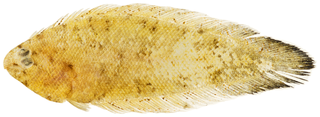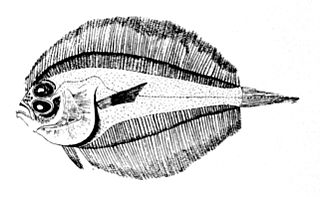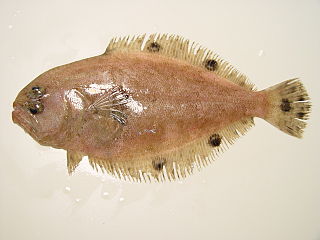
Citharichthys is a genus of flatfish in the large-tooth flounder family, Paralichthyidae. They have both eyes on the left sides of their heads. They are native to the oceans around the Americas, with a single species, C. stampflii off the West African coast. Most are found in relatively shallow depths, but the genus also includes species found in deep water and species that enter fresh water.

Symphurus is a genus of fish in the family Cynoglossidae found in the Atlantic, Indian and Pacific Ocean. Most species mainly occur in relatively shallow water, including estuaries. Some species are also found in deeper water, including S. thermophilus that lives at hydrothermal vents. These species are distinguished by merged dorsal, caudal and anal fins, the absence of a lateral line and pectoral fins, and the presence of only one pelvic fin. They are sinistral flatfishes, meaning that as adults, their crania are asymmetrical, with both eyes on the left side. The largest species grows to about 32 cm (1 ft) long.

Pseudopleuronectes is a genus of righteye flounders mostly native to the northwestern Pacific Ocean with one species found in the northwestern Atlantic Ocean.

Poecilopsetta is a genus of small righteye flounders mainly found in deep water in the Indo-Pacific. Two species, P. beanii and P. inermis, are from the West Atlantic.

Etropus rimosus, the gray flounder, is a species of flounder in the large-tooth flounder family Paralichthyidae. It is native to the western Atlantic Ocean, ranging from the coast of North Carolina to the south of Florida. It can also be found in the eastern Gulf of Mexico.

Hypsoblennius is a genus of combtooth blennies found in the Pacific and Atlantic Oceans.

Bothus is a genus of flatfish in the family Bothidae from the Pacific, Indian and Atlantic Oceans. Some species in this genus have spots consisting of blue rings.

Achirus is a genus of American soles native to tropical and subtropical parts of the Americas. They are mainly found in coastal areas, including salt and brackish water, but some species are found in fresh water.

Crossorhombus is a genus of small lefteye flounders native to the Indian and West Pacific Oceans.

Engyprosopon is a genus of small lefteye flounders. They are found in the Indo-Pacific, ranging from shallow coastal waters to depths in excess of 400 m (1,300 ft).
Grammatobothus is a genus of small lefteye flounders native to the Indo-Pacific.

Laeops is a genus of small lefteye flounders from the Indo-Pacific. They are mainly found in deep water, although a few species have been recorded shallower than 100 m (330 ft).

Parabothus is a genus of fish in the family Bothidae native to the Indian and Pacific Ocean.

Psettina is a genus of small lefteye flounders native to the Indo-Pacific.

Ancylopsetta is a genus of large-tooth flounders mostly found along the Atlantic coast of the Americas with one species found along the Pacific coast.

Cyclopsetta is a genus of large-tooth flounders native to the coastal waters of the Americas.

Paralichthys is a genus of large-tooth flounders. Most species are native to the coastal waters of the Americas, but P. olivaceus is from northeast Asia. The largest species reaches about 1.5 m (5 ft) in length.

Syacium is a genus of large-tooth flounders found in the Atlantic and Pacific Oceans. With the exception of S. guineensis from the Atlantic coast of Africa, all species are from the Americas. The largest species in the genus reaches 40 cm (16 in) in length.
Xystreurys is a genus of large-tooth flounders with one species, X. liolepis, found along the Pacific coast of North America from Monterey Bay, California to the Gulf of California and the other, X. rasile, found along the Atlantic coast of South America from Rio de Janeiro, Brazil to the southern tip of Argentina.

Synaptura is a genus of soles. Most species are found in salt and brackish water in the Indo-Pacific and tropical East Atlantic, but S. salinarum is restricted to fresh water in Australia. The largest species in the genus reaches a length of 50 cm (20 in).

















